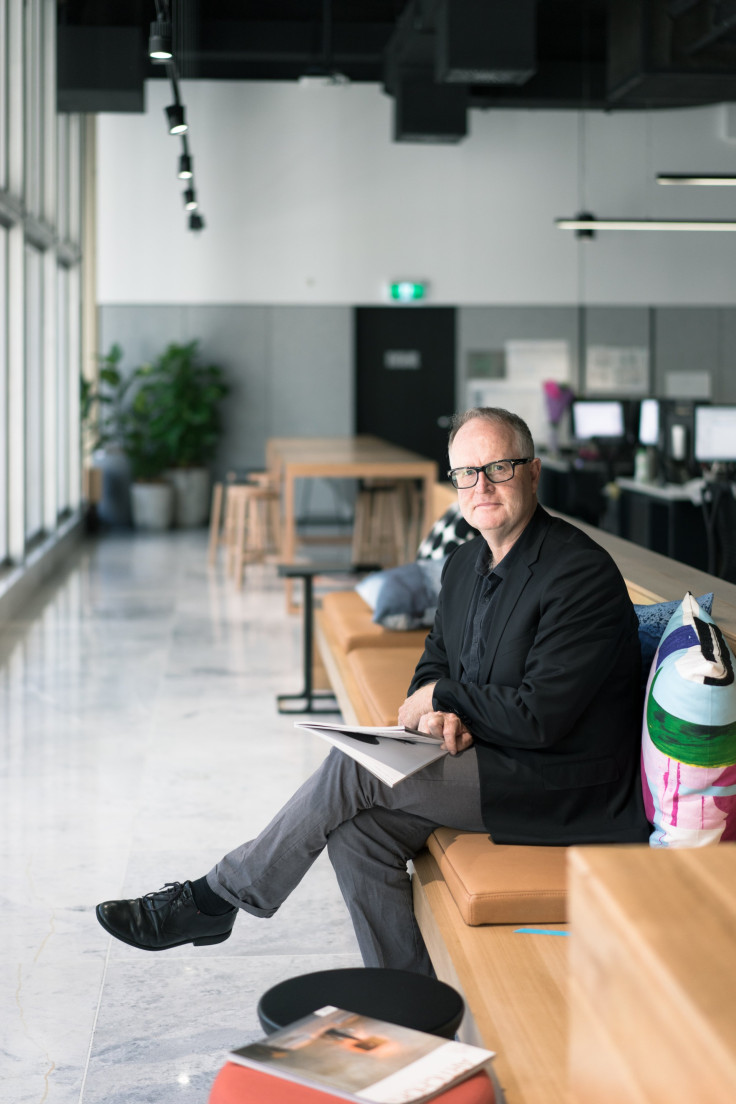Faces Of Our Economy: a Woods Bagot design director, the reinvention of Brisbane and the business of architecture

The Economy is a big word that gets thrown around by politicians and professionals, businessmen and social workers, lecturers and students. It is usually associated with words like demand and supply, boom and bust, trade, distribution and production, but we at IBTimes Australia believe there’s more to our economy than just statistics and percentages. Our economy is made up of success stories, failures and everything in between, all of which would not exist without people.
Faces of our Economy is a campaign that seeks to dive deeper into the makeup of the Australian economy - Australians from all walks of life, and at different stages of their journey.
Brisbane has for years hidden in the shadows of Sydney and Melbourne, whether the spotlight is on culture and lifestyle, or business and the economy. But if its changing cityscape is anything to go by, Australia’s ‘third capital’ could emerge from backstage to star in its own show -- one with a rejuvenated CBD that could set up the local economy for years to come.
Tagged by investors and the local media as the next real estate hotspot in Australia, the Queensland capital has also received increasing international recognition as a city to be reckoned with -- fDi Magazine’s 2014/15 Global Cities of the Future awards ranked Brisbane amongst the top 10 places in the world for human capital and lifestyle -- giving it all the ingredients it needs to fulfill its label as “Australia’s new world city”.
While this acceleration has largely been attributed to private and government forces, there is one group of people who has a say as to whether or not Brisbane thrives or goes stale in the long run: Architects and Building Designers.
Mark Damant is one of the leaders of this industry of professionals. The Design Director of architecture practice Woods Bagot’s Brisbane Studio, Damant is part of the team driving some of Brisbane’s biggest developments, such as Howard Smith Wharves, a 3.43 hectare site that will connect the New Farm Riverwalk and the CBD, and introduce new public spaces for residents and visitors.
Speaking to the 50-year-old architect on a Monday morning highlights how little we think about architecture and design when we talk about the economy. More than simply putting blocks together like Lego pieces, the economic role of architects transcends jobs creation, both during and after construction. In fact, they go one step further to help boost the dollars flowing into the city by creating a new identity for Brisbane.
“Just like MONA in Hobart has actually changed the economy of Tasmania, projects like [Howard Smith Wharves] will do a similar thing, where people will come into the city to visit these new developments,” Damant explains.
“The spinoff for the economy is that people will start to spend money for recreation and shopping, with the CBD becoming a much more vibrant environment.”

“Unlike any other project, Howard Smith Wharves is really going to redefine the way people think about the city after hours and the way people think about the city for recreation. At the moment, from a recreational point of view, there’s no real centre of gravity in the city; it’s pretty scattered,” he says.
“Howard Smith Wharves is really going to give people an impetus to come to the city at night, sit by the river, enjoy a beer and a meal with friends, in the most spectacular setting beneath the Story bridge. It’s like a bit of Brooklyn in Brisbane.
“One of Brisbane’s legacies is that it hasn’t been seen as a 24/7 city by the general population. Projects like [Howard Smiths Wharves] will alter that perception so people will go to the city all hours of the day, and that’s going to create a much more vibrant economy,” he adds.
An architect’s Story

The path to becoming one of the key stakeholders of Brisbane’s reinvention wasn’t clear from the beginning for Damant. The South African native tells IBTimes Australia that he got into architecture simply because he liked to draw as a child. In fact, the business of city-making and creating livable spaces came much later.
“About 10 years ago, I turned 40 and I was thinking it was time to get serious and actually look for a proper career,” Damant says, eliciting a chuckle from us. He had previously worked with leading architecture firms Donovan Hill and Denton Corker Marshall, before receiving a “serendipitous” phone call one day that led him to join Woods Bagot in reviving its Brisbane studio.
“[I developed the understanding of architecture as an avenue of building cities) when I joined Woods Bagot. For me, personally, it was the first time I had to take full responsibility for the entire process. In my previous roles, there was always someone else finding the work, creating the opportunity, and developing the reason for the project.
“When I joined Woods Bagot, the ball was in my court to create the conditions around which a project might be created. Those conditions have to do with meeting the right people, and providing the most appropriate solution to a problem or a challenge or a brief.”
Damant adds that a lot of the work Woods Bagot wins is though competitions -- a process he admits he likes because it “enables the opportunity to try and redefine what a client may think they want, and try to elevate the solutions so they get more out of their project than they anticipated at the beginning”.
While being a major player who gets to shape Brisbane’s growth is deeply satisfying – “the best part of my job is being a part of something bigger than myself” – the pressure on Damant and his team, and undoubtedly the other architects they work alongside to reinvent Brisbane, is massive.
“Buildings are built for the long term and we really feel the pressure to make sure that the fundamental decisions on the commencement of a project are the right decisions,” he reflects.
“Ensuring that they are executed and delivered through the construction phase also puts pressure on us as creators of the built environment, because people will use those buildings, and we want to make that experience of use as good as possible.”
The Business of Architecture
The ties between design firms and the economy, however, doesn’t just stop at city-making. Just like the construction and property development firms they partner with, architects are also intimately tied to the swings of the economy, with Damant observing that buyers and developers are currently not as bullish as they were 12 months ago. This declining confidence invariably affects the firm’s pipeline of work.
“The big challenge in the building industry is the cyclical nature of the economy. We have boom times, and it’s not that we have bust times the way people say, but we definitely have periods of slowdown,” he says.
“One of the main challenges in our industry is ensuring resourcing is appropriate for every project, given those circumstances of a waxing and waning economy. Maintaining a strong team consistently is one of our main challenges, and balancing the skills and experiences that all people in our studio have got, and getting them to work on the right project, is important.”


To combat downturns, Woods Bagot employs a business model it calls ‘One Studio’, whereby the company thinks of itself as more than a collective of individual studios. As a result, the firm’s resource pool, ownership model and financial system are thought of in singular terms, and work is equally distributed between different studios, including those located outside of Australia.
“The worse thing that can happen to us is when a studio gets depleted because of the local economy. When that economy bounces back, it is very difficult to hire a similar team. Experience is very important to us,” Damant explains.
“While that’s a major challenge, because people are naturally very proud of the work they are doing, the company puts a huge effort into making sure that the whole of its staff is being looked after and protected against any local variance in the economy.”
In fact, Damant points out, Woods Bagot’s American studios were opened around and just after the Global Financial Crisis hit -- a move only made possible with the company’s support during the first few years “when the American and Middle Eastern economy in particular were really badly affected”.
While it remains to be seen whether this business model is as lauded for those in the firm who are not part of management, the business model seems to have performed well for the practice’s global expansion. Over the last three consecutive years, Woods Bagot has been ranked by London’s “Building Design” magazine as Australia’s top architecture firm by size, and the world’s seventh largest. It is also now identified as a global architecture practice rather than just an Australian firm with offices abroad.

While the business of architecture spins its wheels, the seemingly more important question for the industry is what is next for architects as designers. Damant’s advice to fresh graduates includes embracing digital media and information management, and understanding how to use the amount of data in the industry to optimise a building’s performance, particularly when it comes to energy use.
“The other issue of our time is housing people in less advantaged places,” he adds. “Politically and culturally, what I call the ‘west’ or the wealthier countries of the world have really got to start paying more attention to less advantaged places around the globe. If you just look at Syria and the catastrophe that those people have gone through, and the impact of that on Europe in particular, if two or three of those events occurred, the world would be in crisis.”
“I believe architecture has got a role to play here [in addition to the role of politicians] – more energy conscious, more efficient, and better designed buildings and environments. We should be responsible, and careful with opulence.
“One of the things that I’m noticing in the new generation and newer graduates is a higher level of ethics and responsibility, particularly with regard to community and the global climate. It’s amazing the level of responsibility you see, and they’ll be able to put their money where their mouth is.”




















